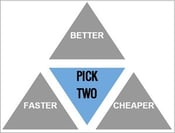 One of the best parts of my job is talking to entrepreneurs in the sales technology space. The other day, I took a call from a stealth-mode founder with a bold vision.
One of the best parts of my job is talking to entrepreneurs in the sales technology space. The other day, I took a call from a stealth-mode founder with a bold vision.
Here’s his pitch:
If you’re generating inbound leads and are focused on setting introductory meetings/demos for sales reps, technology can replace your entire SDR team.
Provocative, right?
He argued that for many inbound SDR organizations, all they do is push the meeting. They send email after email and answer every question a prospects asks with “you’ll find that out if you take the meeting.”
In a way, I agree with him. Far too many teams are doing little more than identifying the guy, checking for a pulse, and closing on the meeting. There’s little-to-no vision creation or pain/consequence discovery. This approach can work beautifully when the goal is "getting more and more at bats” for the sales team.
Add two parts leads and script to one part recent grads and, presto, meetings!
 I asked my good buddy John Barrows for his take. He shared:
I asked my good buddy John Barrows for his take. He shared:
At the low end, I can see the average Inbound SDR getting replaced by automation. Technology is starting to be very targeted with messaging based on business intelligence, predictive analytics, and big data. Add to that buyers having increasing access to information. So you have those two factors merging, and then you have SDRs sitting in the middle getting lazier and lazier. They’re blasting out template emails, going through checkbox questions, and throwing up generic pitches. I believe that in the next three to five years, technology is going to straight up replace them.
Is John being controversial? Absolutely and nobody does it better. But I agree with John’s core point. We are obsessed with technology and we’re potentially automating the “human” out of the sales process.
Now I don’t know about you, but sometimes I can’t tell if an SDR on the other end of an email is man or machine. It’s all so canned, generic, and formulaic that it could just be an algorithm.
My point here isn’t that we should develop technology on par with the average SDR, it’s that we should raise the performance of the average SDR to heights that code could never reach.
I like to interact with humans.
I don’t want a technology pen pal. I'd rather not have Siri close me on a meeting.
I don’t believe that automation can engage and move the sales process forward the way a person can. Having said that, the person should sound less like a robot and more like a professional who knows enough about me, my industry, and my business to be worthy of attention.
The need to be interesting and relevant holds true from first touch to last. Even if your Inbound SDRs are setting introductory meetings, you have to be sure you're providing them with the skills and the training they need to be agile and not on auto-pilot.
Now if your SDRs sound like robots, maybe you should replace them with automation. You might not get the same results, but it would certainly be a lot cheaper.
What say you?
